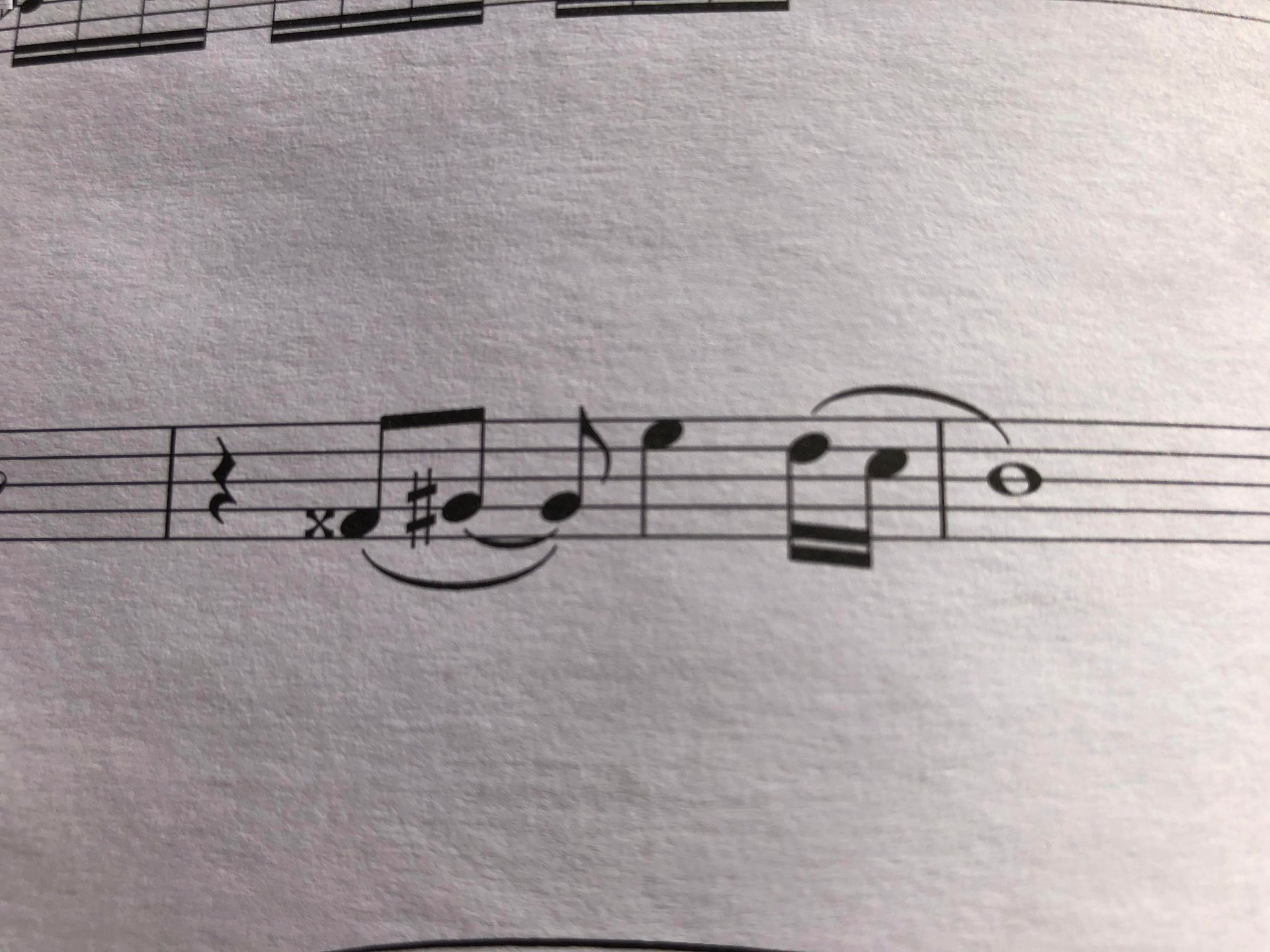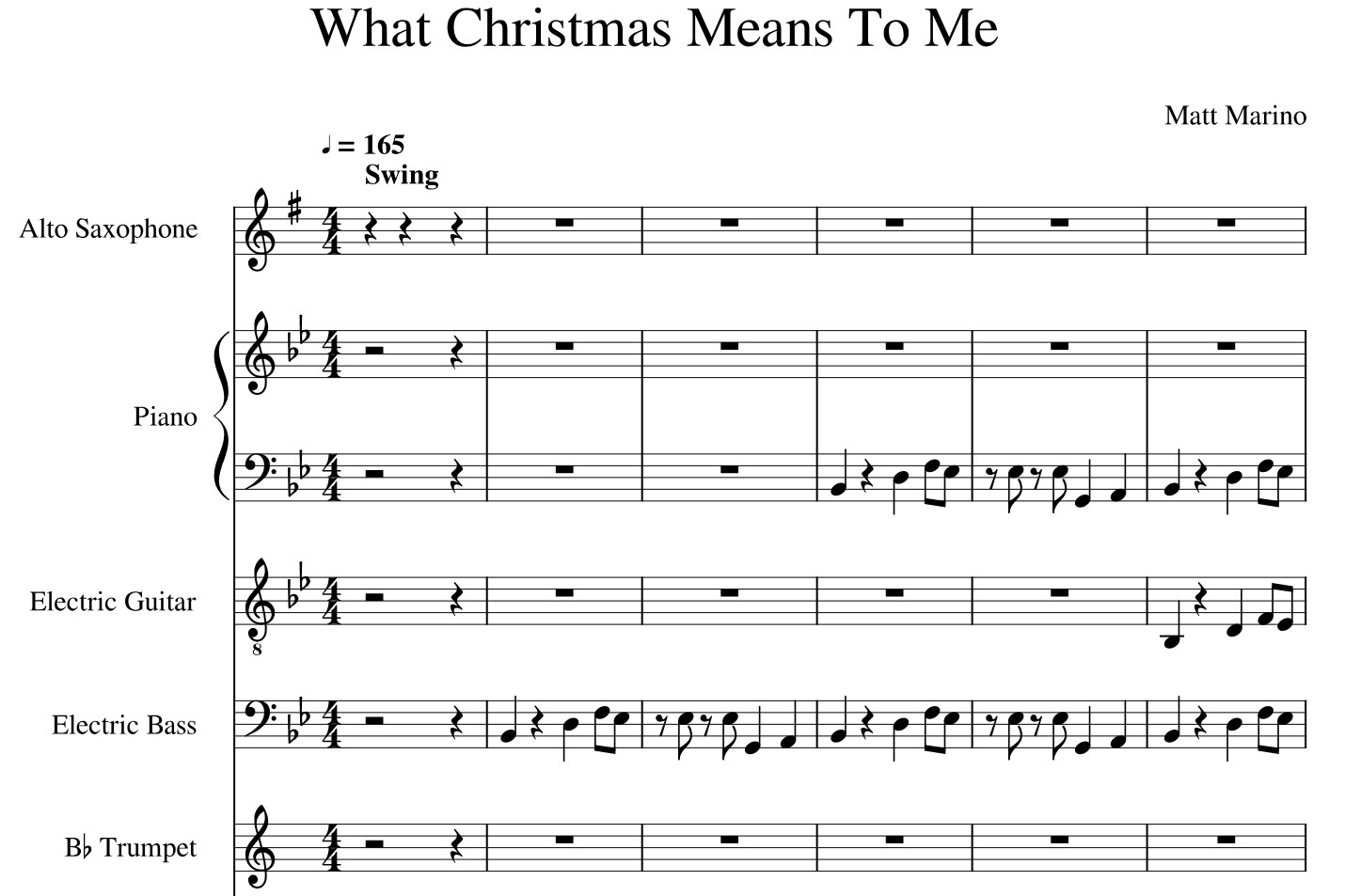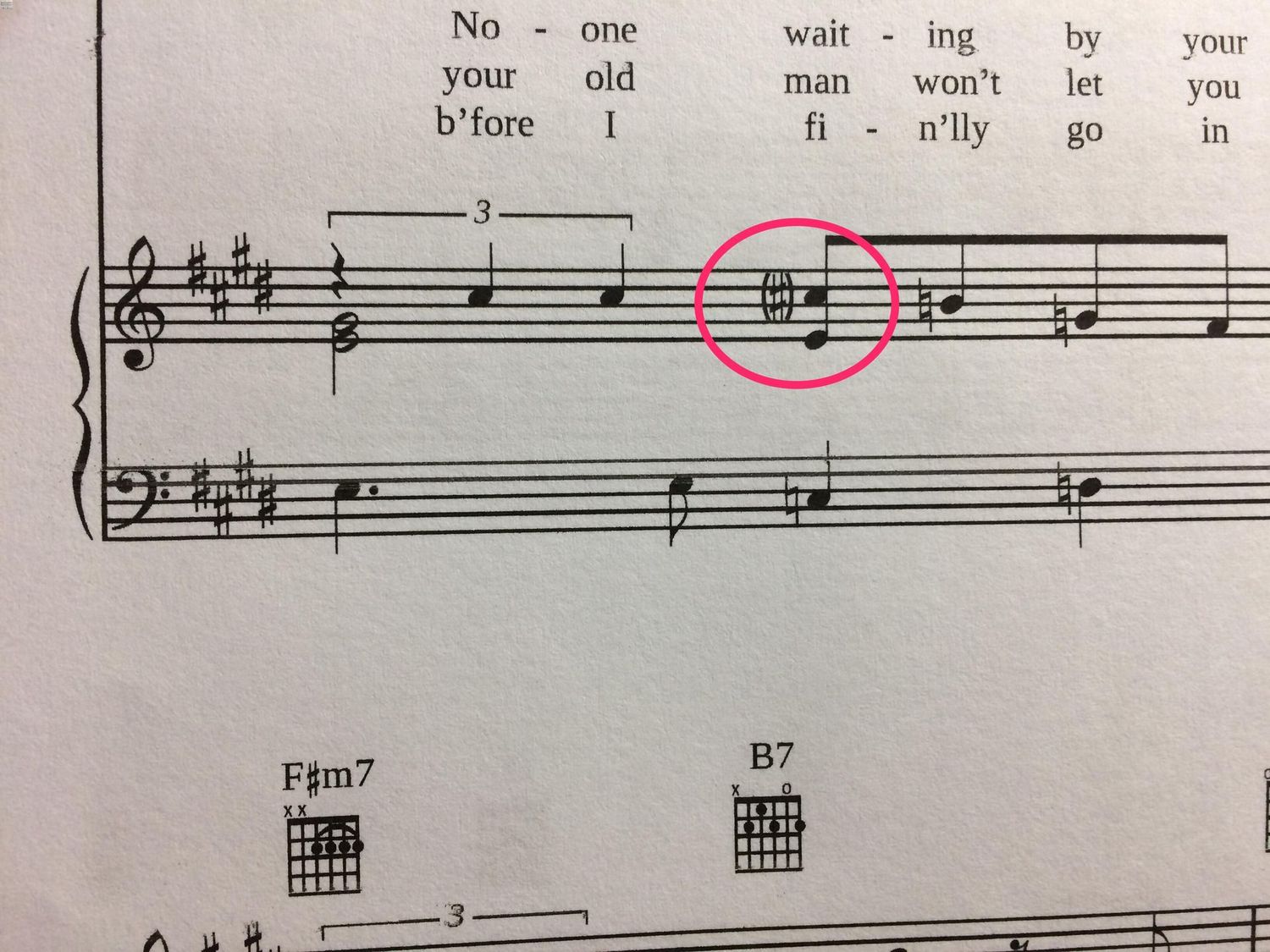Home>Production & Technology>Sheet Music>What Does An X Mean In Sheet Music


Sheet Music
What Does An X Mean In Sheet Music
Modified: January 22, 2024
Discover the meaning of an "X" in sheet music and unlock its significance. Dive into the world of sheet music with expert insights and uncover the secrets of this musical notation.
(Many of the links in this article redirect to a specific reviewed product. Your purchase of these products through affiliate links helps to generate commission for AudioLover.com, at no extra cost. Learn more)
Table of Contents
Introduction
Welcome to the world of sheet music! Whether you’re an aspiring musician, a music enthusiast, or a seasoned player, sheet music is a vital tool for communicating musical ideas. It allows performers to interpret melodies, harmonies, rhythms, and dynamics that make up a piece of music. But what about those mysterious symbols and markings found on sheet music? One such symbol that often raises questions is the letter “X”. In this article, we will explore the meaning and significance of the “X” symbol in sheet music notation.
Sheet music is a written form of musical notation that represents various elements of a musical composition. It uses a combination of symbols, staff lines, and pitch and rhythm notations to guide performers. Every note, rest, dynamic, articulation, and expression is notated in a specific way, providing musicians with a roadmap to bring the music to life.
However, sheet music is not just limited to instruments. It is also used in vocal music, choral arrangements, and even in transcriptions for orchestras. Regardless of the context, sheet music serves as a universal language for musicians to communicate and perform music accurately.
The “X” symbol is one of the many markings you may come across while reading sheet music. Its purpose can vary depending on the instrument, style of music, or specific notation system being used. It can represent different musical techniques or indicate a specific action or instruction for the performer.
In the following sections, we will delve deeper into the basics of sheet music and explore the specific meanings and interpretations associated with the “X” symbol in different musical contexts. Whether you’re a curious beginner or an experienced musician, this article will shed light on the mysteries behind this intriguing symbol.
Understanding Sheet Music Notation
Sheet music notation is a standardized system of symbols and notations used to represent musical elements in a written form. It serves as a means of communication between composers, arrangers, and performers. Understanding sheet music notation is essential for musicians to accurately interpret and perform the music.
The fundamental components of sheet music notation include the staff, clefs, time signatures, key signatures, notes, rests, and various symbols and markings. The staff consists of five horizontal lines and four spaces, on which notes and other notations are placed. Clefs, such as the treble clef and bass clef, indicate the position and pitch range of the notes on the staff.
Time signatures denote the rhythmic structure of the music, representing the number of beats in each measure and the type of note that receives one beat. Key signatures indicate the key of the music and the placement of sharps or flats throughout the piece.
Notes and rests are symbols used to represent the duration of sounds and silences in music. Each note has a different shape and position on the staff to indicate its pitch, while rests indicate periods of silence. Dynamics, such as pianissimo (pp) and fortissimo (ff), indicate the volume or intensity of the music. Articulation markings, such as staccato dots or legato lines, provide instructions on how to play or sing the notes.
Sheet music notation can be complex and intricate, requiring understanding and practice to read and interpret effectively. Musicians spend years honing their skills in deciphering the notation and bringing it to life through their performance.
By understanding sheet music notation, musicians gain the ability to accurately convey the composer’s intentions, interpret musical nuances, and express their own musicality. It is a language that transcends cultural and linguistic barriers, allowing musicians from different backgrounds to come together and create beautiful music.
Next, let’s explore the significance and interpretations of the “X” symbol in sheet music notation.
Basics of Sheet Music
Before delving into the specific meanings of the “X” symbol in sheet music, let’s first establish a foundation by discussing the basics of sheet music.
Sheet music is a written representation of a musical composition, providing a visual guide for musicians to perform the piece accurately. It incorporates various elements such as notes, rests, time signatures, key signatures, dynamics, and more to convey the composer’s musical ideas.
The staff is the foundation of sheet music, consisting of five horizontal lines and four spaces. Each line and space represents a different pitch, allowing musicians to determine the notes to be played. Clefs, such as the treble clef and bass clef, are used to establish the pitch range and position of the notes on the staff.
Notes represent the duration and pitch of a sound. They come in different shapes and positions on the staff, indicating their duration and pitch level. The duration of notes is determined by the presence of flags and stems attached to the noteheads.
Rests, on the other hand, represent periods of silence or pauses in the music. They are essential for creating rhythmic patterns and providing space between notes.
Time signatures give musicians information about the meter and rhythmic structure of the music. They consist of two numbers stacked vertically at the beginning of each staff. The top number indicates the number of beats in each measure, while the bottom number represents the type of note that receives one beat.
Key signatures provide information about the tonality of the piece. They consist of a series of sharps or flats located at the beginning of each staff. Key signatures establish the tonal center and determine the arrangement of accidentals throughout the piece.
Dynamics and articulations are markings that indicate the volume, intensity, and expression required for a specific passage. Common dynamic markings include pianissimo (pp), piano (p), mezzo (m), forte (f), and fortissimo (ff). Articulation markings, such as staccato dots, legato lines, and accents, instruct musicians on how to play the notes with clarity and precision.
By understanding the basics of sheet music, musicians can effectively interpret and perform a wide range of musical compositions. It allows them to accurately convey the composer’s intentions and bring the music to life.
Now that we have a solid understanding of sheet music, let’s dive into the significance and interpretations of the “X” symbol in sheet music notation.
Significance of X in Sheet Music
The letter “X” holds various significances and interpretations in the realm of sheet music notation. Its purpose can differ depending on the specific instrument, musical genre, or notation system being used. Let’s explore some common meanings of the “X” symbol in sheet music.
1. Staccato Marking: One of the most common interpretations of the “X” symbol in sheet music is its use as a staccato marking. When a note or a series of notes have small “X” symbols placed above or below them, it indicates a short and detached articulation. Musicians are instructed to play or sing these notes with a crisp and brief duration.
2. Muted or Damped Notes: In certain musical contexts, the “X” symbol can represent muted or damped notes. For example, in brass or wind instruments, the “X” symbol above a note indicates that the player should use a muted or dampened technique to produce a more subdued and muted sound.
3. Ghost Notes: The “X” symbol can also signify ghost notes in certain genres, such as jazz or funk. Ghost notes are quiet and lightly played percussive sounds that contribute to the rhythmic complexity and groove of the music. The “X” symbol above a note suggests that it should be played softly or lightly, enhancing the rhythmic feel of the piece.
4. Crossing of Hands or Fingers: In piano sheet music, the letter “X” can indicate the crossing of hands or fingers over one another. This is commonly seen in more complex piano compositions where the pianist needs to maneuver their hands to play multiple notes simultaneously.
5. Indication for Cancellation: In some cases, the “X” symbol is used as a cancellation symbol. It may appear beside a note or chord that was previously indicated but is no longer applicable. This can happen when correcting a previous instruction or when transitioning between different musical sections.
It’s worth noting that the significance of the “X” symbol can vary depending on the music notation system used. Different composers and arrangers may have their own unique interpretations of the symbol, so it’s essential to refer to the specific instructions provided on the sheet music.
By understanding the different meanings of the “X” symbol in sheet music, musicians can accurately interpret and bring out the intended musical expression and technique specified by the composer. The “X” symbol adds depth and nuance to sheet music notation, allowing for a richer and more dynamic interpretation of the music.
In the next section, we will explore the specific interpretations of the “X” symbol in sheet music for different instruments.
X Markings in Different Instruments
The interpretation of “X” markings in sheet music varies across different instruments. Let’s explore how the “X” symbol is utilized in the notation of various instruments:
1. Guitar:
In guitar sheet music, the “X” symbol is often used as a notation for a muted or damped string. It indicates that a particular string should be lightly touched or muted with the fretting hand to produce a percussive sound rather than a sustained note. This technique adds rhythmic interest and texture to the music, commonly seen in genres like funk, rock, and reggae.
2. Percussion:
In percussion notation, “X” markings can represent different instruments or techniques. For example, in drum notation, an “X” symbol above a note indicates a muted or closed hi-hat sound. In other cases, the “X” symbol may indicate a particular drum or percussion instrument to be played at a specific moment.
3. Brass and Woodwinds:
In brass and woodwind instruments, the “X” symbol may be used to indicate extended techniques or unconventional playing methods. For instance, an “X” above a note in trumpet music may indicate a note to be stopped with the hand in the bell, producing a muted or altered sound. In woodwind notation, the “X” symbol may be used to signify fingerings or alternate fingerings for specific notes.
4. Strings:
In string instrument notation, the “X” symbol can represent various techniques, such as a muted string or crossed strings. For example, in violin sheet music, an “X” marking above a note may signify a muted or dampened sound produced by lightly touching the string with the finger or bow hair. In advanced string techniques, the “X” symbol can indicate the need to cross strings or perform intricate bowing patterns.
5. Piano:
In piano music, the “X” symbol often represents the crossing of hands or fingers over one another. This occurs when the right hand plays notes that would typically be played by the left hand or vice versa. The “X” symbol helps pianists navigate complex passages and hand coordination in pieces that require advanced technical skills.
These are just a few examples of how “X” markings are used in different instruments. It’s important for musicians to consult instrument-specific notation guides or seek clarification from their instructors or composers for precise interpretations in their sheet music.
Next, let’s explore how to interpret “X” markings in sheet music to effectively bring out the intended musical expression and technique.
Interpreting X Markings in Sheet Music
Interpreting “X” markings in sheet music requires careful attention to context and understanding of the specific instrument or notation system being used. Here are some guidelines for effectively interpreting “X” markings:
1. Read the Notation Key: Before diving into the music, familiarize yourself with the notation key provided in the sheet music. It will outline the specific meanings of various symbols and markings used, including the interpretation of “X” markings. Understanding the notation key will give you valuable insights into how to approach these markings throughout the piece.
2. Consider the Instrument: Keep in mind that the interpretation of “X” markings can vary depending on the instrument. Different instruments may have their own unique techniques or performance practices associated with “X” markings. Take into account the instrument-specific nuances and consult resources or experts for guidance if needed.
3. Pay Attention to Context: The meaning of “X” markings can be context-specific within a piece of music. Look for patterns or recurring instances of “X” markings. Consider the surrounding musical elements such as dynamics, articulations, and phrasing to understand how the “X” markings contribute to the overall musical expression.
4. Consult Other Performances or Recordings: Listening to various recordings or performances of the same piece can provide valuable insight into the interpretation of “X” markings. Pay attention to how different musicians approach these markings and consider incorporating elements that resonate with your own musical interpretation.
5. Seek Guidance from Instructors or Composers: If you’re unsure about the meaning of “X” markings in your sheet music, don’t hesitate to seek guidance from your instructors or composers. They can offer valuable explanations and insights into the intended interpretation, helping you bring out the desired musical expression effectively.
Remember, while sheet music provides a framework, it also allows room for artistic interpretation. Use your musical intuition, knowledge, and creativity to infuse your performance with personal expression while honoring the composer’s intentions as best as you can.
Next, let’s explore some common examples of “X” markings in sheet music and their specific interpretations.
Common Examples of X Markings in Sheet Music
Let’s explore some common examples of “X” markings in sheet music and their specific interpretations:
1. Staccato Marking: The “X” symbol is often used as a staccato marking, indicating that a note or a series of notes should be played or sung with a short and detached articulation. This means that each note is given a distinct and crisp sound with a brief duration. The “X” can appear above or below the noteheads to signify this staccato technique.
2. String Muting: In string instrument notation, the “X” symbol is used to indicate that a particular string should be lightly touched or muted with the finger. This produces a more percussive sound instead of a sustained note. Musicians achieve this muted effect by placing a finger on the string without fully pressing it down against the fingerboard. The “X” marking indicates the specific string or strings that should be muted.
3. Crossed Hands or Fingers: In piano sheet music, the letter “X” is commonly used to indicate the crossing of hands or fingers over one another. This occurs when the right hand plays notes typically handled by the left hand or vice versa. The “X” symbol helps pianists navigate complex passages and coordinate their hands effectively. It indicates an overhand crossing or underhand crossing, depending on the hand position required.
4. Percussive Techniques: In percussion notation, the “X” symbol can indicate various percussive techniques. For example, an “X” above a note may signify a muted or closed sound produced by instruments like the hi-hat or cymbals. It can also represent specific drum hits or effects. The interpretation of “X” markings in percussion notation may differ depending on the specific instrument and the desired effect in the music.
5. Striking or Brushing Techniques: In some cases, the “X” symbol in sheet music can indicate striking or brushing techniques. For example, in guitar or ukulele music, “X” markings may represent specific string strumming patterns or rhythmic effects. Drummers may also encounter “X” markings to indicate brush strokes on their drumheads.
Remember, the specific interpretation of “X” markings may vary depending on the composer’s intent and the context within the piece. It is crucial to refer to the notation key and consult resources or experts for guidance if the meaning is unclear.
By understanding these common examples of “X” markings in sheet music, musicians can effectively incorporate the intended techniques and express the desired musical elements in their performances. It adds depth and character to the music, enhancing the overall musical experience.
Now that we have explored the significance, interpretations, and common examples of “X” markings in sheet music, let’s conclude our journey into this intriguing aspect of musical notation.
Conclusion
Sheet music notation is a universal language that allows musicians to communicate and perform music accurately. Within this system, the letter “X” holds various interpretations and significances depending on the instrument, musical genre, or notation system being used.
Understanding sheet music notation is essential for musicians to effectively interpret and perform the music. By grasping the basics of sheet music, including the staff, notes, rests, time signatures, key signatures, dynamics, and articulations, musicians can navigate the intricacies of musical notation with confidence.
The “X” symbol in sheet music notation represents different techniques and instructions, such as staccato articulation, string muting, crossed hands or fingers, and percussive effects. Its interpretations may vary across instruments and musical genres, emphasizing the importance of instrument-specific notation guides and seeking guidance from instructors or composers when needed.
Through careful interpretation and attention to context, musicians can bring out the intended musical expression and technique signified by “X” markings in their performances. By consulting notation keys, listening to recordings, and considering instrument-specific approaches, musicians can add depth and nuance to their interpretations.
Sheet music notation, including the enigmatic “X” symbol, is a powerful tool for musicians to communicate and express their musical ideas. By honing their skills in interpreting and performing sheet music, musicians can faithfully represent the intentions of composers and engage listeners with captivating performances.
So, as you encounter the letter “X” in sheet music, remember to embrace the interpretive possibilities and unlock the creative potential it holds. It is through this understanding and exploration of sheet music notation that musicians can truly bring the music to life.











